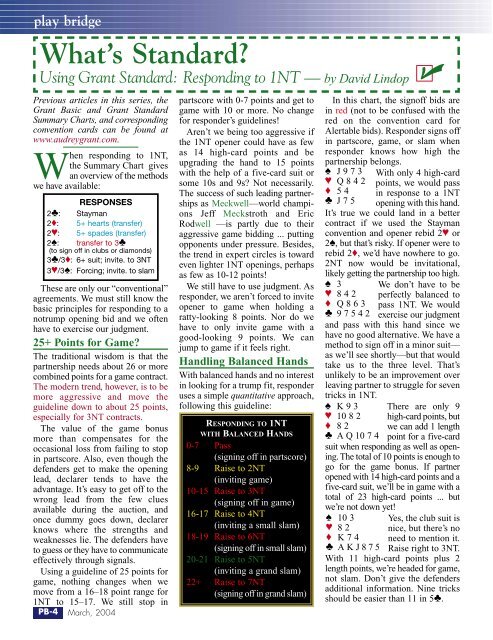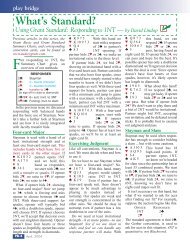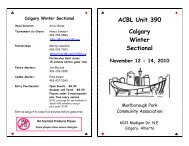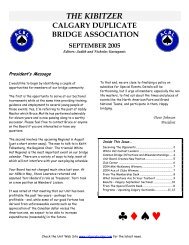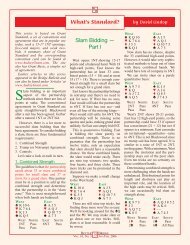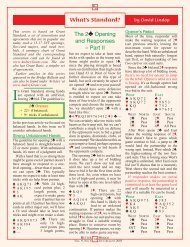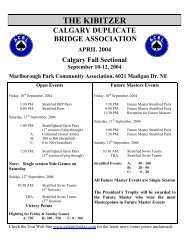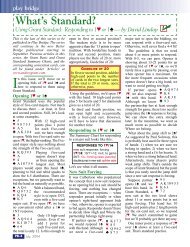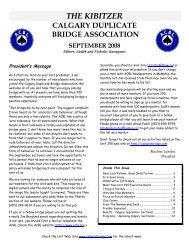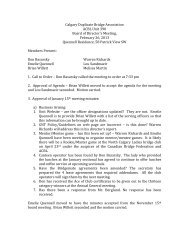Using Grant Standard - Better Bridge
Using Grant Standard - Better Bridge
Using Grant Standard - Better Bridge
Create successful ePaper yourself
Turn your PDF publications into a flip-book with our unique Google optimized e-Paper software.
play bridge<br />
What’s <strong>Standard</strong><br />
<strong>Using</strong> <strong>Grant</strong> <strong>Standard</strong>: Responding to 1NT — by David Lindop<br />
Previous articles in this series, the<br />
<strong>Grant</strong> Basic and <strong>Grant</strong> <strong>Standard</strong><br />
Summary Charts, and corresponding<br />
convention cards can be found at<br />
www.audreygrant.com.<br />
When responding to 1NT,<br />
the Summary Chart gives<br />
an overview of the methods<br />
we have available:<br />
RESPONSES<br />
2♣: Stayman<br />
2♦: 5+ hearts (transfer)<br />
2♥: 5+ spades (transfer)<br />
2♠: transfer to 3♣<br />
(to sign off in clubs or diamonds)<br />
3♣/3♦: 6+ suit; invite. to 3NT<br />
3♥/3♠: Forcing; invite. to slam<br />
These are only our “conventional”<br />
agreements. We must still know the<br />
basic principles for responding to a<br />
notrump opening bid and we often<br />
have to exercise our judgment.<br />
25+ Points for Game<br />
The traditional wisdom is that the<br />
partnership needs about 26 or more<br />
combined points for a game contract.<br />
The modern trend, however, is to be<br />
more aggressive and move the<br />
guideline down to about 25 points,<br />
especially for 3NT contracts.<br />
The value of the game bonus<br />
more than compensates for the<br />
occasional loss from failing to stop<br />
in partscore. Also, even though the<br />
defenders get to make the opening<br />
lead, declarer tends to have the<br />
advantage. It’s easy to get off to the<br />
wrong lead from the few clues<br />
available during the auction, and<br />
once dummy goes down, declarer<br />
knows where the strengths and<br />
weaknesses lie. The defenders have<br />
to guess or they have to communicate<br />
effectively through signals.<br />
<strong>Using</strong> a guideline of 25 points for<br />
game, nothing changes when we<br />
move from a 16–18 point range for<br />
1NT to 15–17. We still stop in<br />
PB-4 March, 2004<br />
partscore with 0-7 points and get to<br />
game with 10 or more. No change<br />
for responder’s guidelines!<br />
Aren’t we being too aggressive if<br />
the 1NT opener could have as few<br />
as 14 high-card points and be<br />
upgrading the hand to 15 points<br />
with the help of a five-card suit or<br />
some 10s and 9s Not necessarily.<br />
The success of such leading partnerships<br />
as Meckwell—world champions<br />
Jeff Meckstroth and Eric<br />
Rodwell —is partly due to their<br />
aggressive game bidding ... putting<br />
opponents under pressure. Besides,<br />
the trend in expert circles is toward<br />
even lighter 1NT openings, perhaps<br />
as few as 10-12 points!<br />
We still have to use judgment. As<br />
responder, we aren’t forced to invite<br />
opener to game when holding a<br />
ratty-looking 8 points. Nor do we<br />
have to only invite game with a<br />
good-looking 9 points. We can<br />
jump to game if it feels right.<br />
Handling Balanced Hands<br />
With balanced hands and no interest<br />
in looking for a trump fit, responder<br />
uses a simple quantitative approach,<br />
following this guideline:<br />
RESPONDING TO 1NT<br />
WITH BALANCED HANDS<br />
0-7 Pass<br />
(signing off in partscore)<br />
8-9 Raise to 2NT<br />
(inviting game)<br />
10-15 Raise to 3NT<br />
(signing off in game)<br />
16-17 Raise to 4NT<br />
(inviting a small slam)<br />
18-19 Raise to 6NT<br />
(signing off in small slam)<br />
20-21 Raise to 5NT<br />
(inviting a grand slam)<br />
22+ Raise to 7NT<br />
(signing off in grand slam)<br />
In this chart, the signoff bids are<br />
in red (not to be confused with the<br />
red on the convention card for<br />
Alertable bids). Responder signs off<br />
in partscore, game, or slam when<br />
responder knows how high the<br />
partnership belongs.<br />
♠ J 9 7 3<br />
♥ Q 8 4 2<br />
♦ 5 4<br />
<br />
With only 4 high-card<br />
points, we would pass<br />
in response to a 1NT<br />
opening with this hand.<br />
♣ J 7 5<br />
It’s true we could land in a better<br />
contract if we used the Stayman<br />
convention and opener rebid 2♥ or<br />
2♠, but that’s risky. If opener were to<br />
rebid 2♦, we’d have nowhere to go.<br />
2NT now would be invitational,<br />
likely getting the partnership too high.<br />
♠ 3<br />
♥ 8 4 2<br />
♦ Q 8 6 3<br />
We don’t have to be<br />
perfectly balanced to<br />
pass 1NT. We would<br />
exercise our judgment<br />
♣ 9 7 5 4 2<br />
and pass with this hand since we<br />
have no good alternative. We have a<br />
method to sign off in a minor suit—<br />
as we’ll see shortly—but that would<br />
take us to the three level. That’s<br />
unlikely to be an improvement over<br />
leaving partner to struggle for seven<br />
tricks in 1NT.<br />
♠ K 9 3<br />
♥ 10 8 2<br />
♦ 8 2<br />
There are only 9<br />
high-card points, but<br />
we can add 1 length<br />
point for a five-card<br />
♣ A Q 10 7 4<br />
suit when responding as well as opening.<br />
The total of 10 points is enough to<br />
go for the game bonus. If partner<br />
opened with 14 high-card points and a<br />
five-card suit, we’ll be in game with a<br />
total of 23 high-card points ... but<br />
we’re not down yet!<br />
♠ 10 3<br />
♥ 8 2<br />
♦ K 7 4<br />
Yes, the club suit is<br />
nice, but there’s no<br />
need to mention it.<br />
Raise right to 3NT.<br />
♣ A KJ 87 5<br />
With 11 high-card points plus 2<br />
length points, we’re headed for game,<br />
not slam. Don’t give the defenders<br />
additional information. Nine tricks<br />
should be easier than 11 in 5♣.
♠ A J 5<br />
♥ K J 6<br />
♦ A Q 6 3<br />
♣ Q J 5<br />
A balanced hand with<br />
18 high-card points.<br />
Raise right to 6NT.<br />
There’s no need to ask<br />
for aces. If partner were to show one<br />
ace, we’d bid 6NT. If partner were to<br />
show two aces, we’d also bid 6NT<br />
since the partnership doesn’t have<br />
enough combined strength for a<br />
grand slam contract.<br />
Could we be missing two aces<br />
It’s possible. Although the partnership<br />
has a minimum of 33 combined<br />
points, partner might have<br />
opened 1NT with 14 high-card<br />
points and a five-card suit or a lot of<br />
10s and 9s. If so, too bad. It’s more<br />
likely that we’re missing the ♣A K,<br />
for example. Asking for aces<br />
wouldn’t help in that situation and it<br />
would risk getting the opponents off<br />
to the right lead.<br />
Notrump slams are typically bid<br />
on straight power, not the refinements<br />
of having specific cards. There’s no<br />
guarantee we’ll make 6NT when we<br />
bid it. A key finesse could lose instead<br />
of win. On the other side, perhaps<br />
the defenders will get off to the only<br />
lead that will let us take 12 tricks. If<br />
we have about 33 or more combined<br />
points with two balanced hands,<br />
let’s go for that big bonus ... and the<br />
added excitement!<br />
The chart for responder’s actions<br />
with balanced hands has two bids in<br />
yellow. These are invitational bids.<br />
Opener is expected to pass with a<br />
minimum of 16 or fewer points or<br />
accept the invitation with a maximum<br />
of 17 points ... or 16 points<br />
and a good excuse.<br />
♠ K 5<br />
♥ 9 6 2<br />
♦ A J 10 7 3<br />
8 high-card points<br />
plus 1 for the fivecard<br />
suit make this<br />
hand worth an invi-<br />
♣ 8 4 2<br />
tational raise to 2NT over 1NT. If<br />
the ♦A were the ♦K, would this still<br />
be worth a raise to 2NT That’s a<br />
matter of judgment, not methods.<br />
We would need to take into account<br />
other factors such as the vulnerability,<br />
the type of scoring—rubber bridge,<br />
teams or matchpoints—and whether<br />
we needed a big swing.<br />
♠ Q 9 5<br />
♥ A 3<br />
♦ K Q 9 5<br />
♣ A J 10 4<br />
With 16 high-card<br />
points, we would<br />
raise 1NT to 4NT.<br />
This isn’t Blackwood.<br />
It’s an invitational—quantitative—<br />
raise, asking whether opener has a<br />
maximum. Opener should pass with<br />
15 or 16 and bid 6NT with 17 ... or<br />
16 and a good feeling.<br />
Opener should not show the number<br />
of aces held, even when accepting the<br />
invitation with a maximum. It only<br />
gives information to the defenders.<br />
In experienced partnerships, the bid<br />
of a suit at the five level by opener<br />
is looking for a 4–4 fit, perhaps<br />
when opener has a low doubleton in<br />
another suit. A jump by opener to<br />
the six level in a suit shows a fivecard<br />
suit, giving responder the<br />
option of playing there or in 6NT.<br />
The most interesting—and least<br />
known—line on the chart is the one<br />
in green, when responder has 20-21<br />
points. A raise to 5NT is forcing. It<br />
asks opener to bid 6NT with a<br />
minimum or 7NT with a maximum.<br />
♠ K Q 4<br />
♥ A Q 8<br />
♦ K Q 7<br />
♣ K J 10 2<br />
With this 20-point<br />
hand we would raise<br />
1NT to 5NT. Opener<br />
would bid 7NT with<br />
17 points, putting the partnership in<br />
its 37-point grand slam. With less,<br />
opener would settle for 6NT.<br />
Since we would be disappointed if<br />
partner were to pass 5NT, we should<br />
simply bid 6NT with this hand if<br />
we’re uncertain whether partner<br />
knows the meaning of 5NT.<br />
Playing in a Suit Contract<br />
We’re often faced with the decision<br />
of whether to play in a suit contract<br />
or in notrump. If we have enough<br />
combined strength for game, for<br />
example, we need only nine tricks<br />
in 3NT rather than 10 tricks in 4♥<br />
or 4♠ or 11 tricks in 5♣ or 5♦.<br />
Experience shows that playing in<br />
an eight-card or longer trump fit will<br />
usually provide at least one more trick<br />
than in notrump, and often two or<br />
more tricks. The guideline, therefore,<br />
is to try play in the major suit with<br />
an eight-card or longer fit.<br />
play bridge<br />
With a minor-suit fit, the situation<br />
is less clear. At the game level, it is<br />
usually best to play in 3NT rather than<br />
5♣ or 5♦. The trump suit may not<br />
provide two more tricks and the trick<br />
score for minor suits is significantly<br />
less than for notrump or major suits.<br />
In partscore or slam contracts,<br />
however, it is usually best to choose<br />
the safety of the minor suit, although<br />
the trick score factor becomes a<br />
consideration in duplicate bridge.<br />
In summary, lot of bidding theory<br />
focuses on finding eight-card or<br />
longer major-suit fits, and the<br />
responses to 1NT are no exception.<br />
Putting Stayman to Work<br />
Next to Blackwood, Stayman is the<br />
most well-known convention, and it is<br />
certainly more useful in terms of frequency<br />
of use. The mechanics are<br />
straightforward. In response to a 1NT<br />
opening, a bid of 2♣ asks opener to<br />
bid a four-card or longer major suit.<br />
Opener rebids as follows:<br />
• 2♦ with no four-card major suit<br />
• 2♥ with four or more hearts<br />
• 2♠ with four or more spades<br />
With four cards in both majors,<br />
<strong>Grant</strong> <strong>Standard</strong> is to rebid 2♥,<br />
consistent with bidding four-card<br />
suits “up the line.”<br />
As a guideline, responder uses<br />
Stayman on any hand with 8 or more<br />
points and at least one four-card<br />
major suit. Let’s see some examples.<br />
♠ A Q 6 2 With 10 high-card<br />
♥ K J 7 5 points, we know the<br />
♦ 9 4 2 partnership belongs<br />
♣ 8 3 in game. To check for<br />
a major-suit fit, we respond 2♣. If<br />
opener rebids 2♥, we raise to 4♥; if<br />
opener rebids 2♠, we raise to 4♠; if<br />
opener rebids 2♦, we jump to 3NT.<br />
♠ 6 4<br />
♥ A J 10 5<br />
♦ K J 8 3<br />
With 9 high-card<br />
points and a four-card<br />
major suit, we bid<br />
2♣. If opener rebids<br />
♣ 10 9 3<br />
2♥, we invite to game by raising to<br />
3♥; if opener bids 2♦ or 2♠, we<br />
invite to game by bidding 2NT.<br />
(In the next issue we’ll look at some more<br />
complex auctions involving Stayman and<br />
then move on to using transfer bids.)<br />
Vol. 8, No. 3<br />
PB-5


